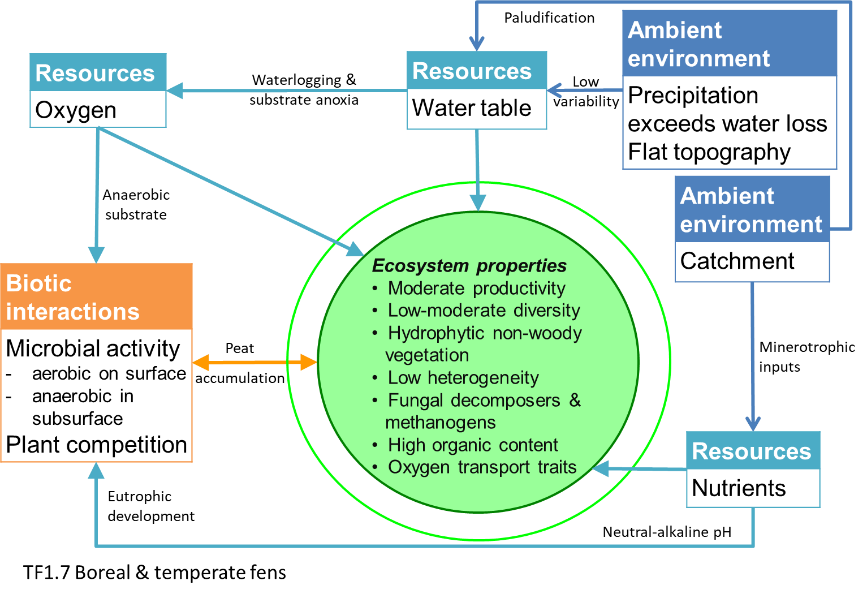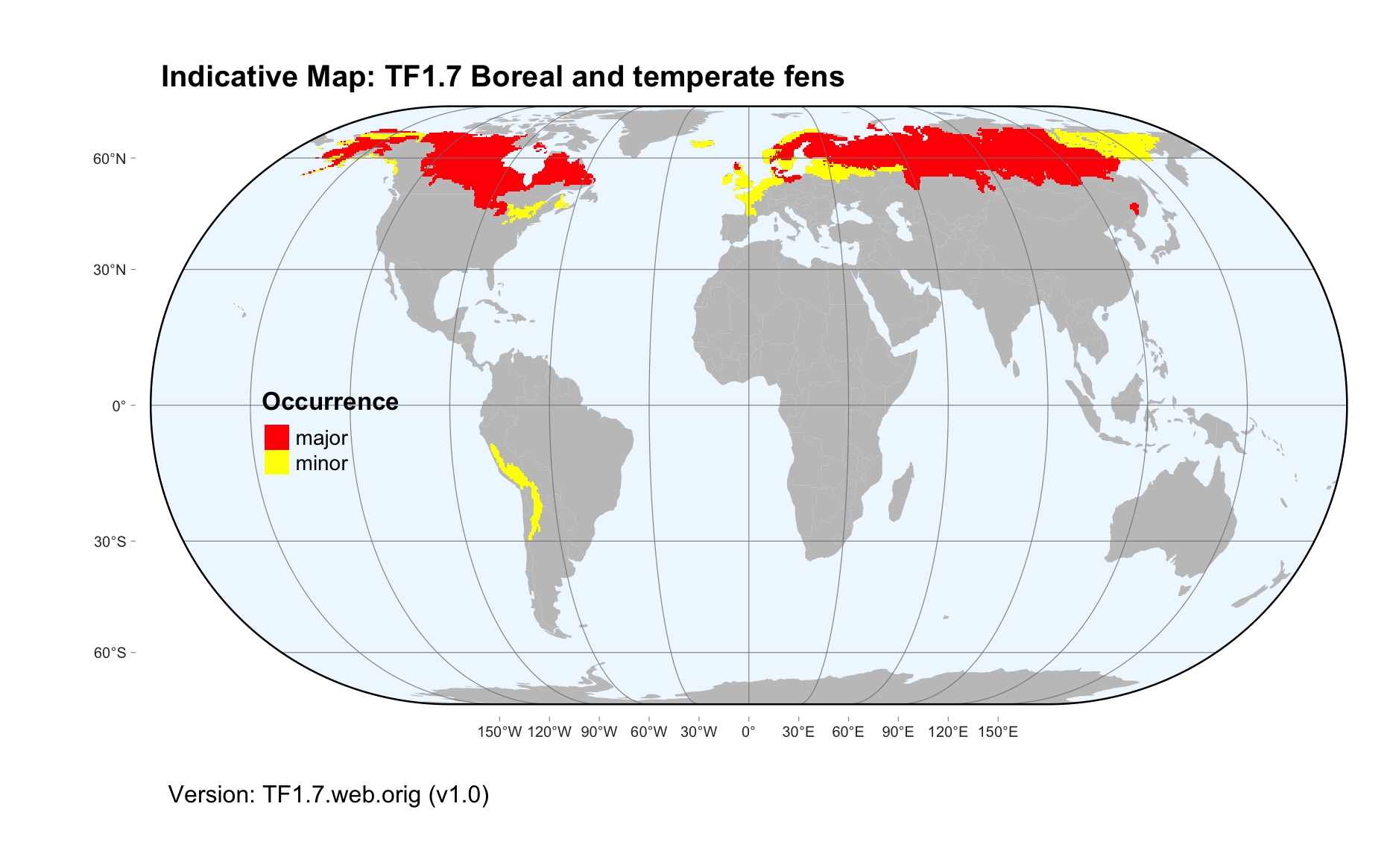Global ecosystem typology
Alternative site for the Global ecosystem typology with additional information for ecosystem profiles and indicative maps.
This site is maintained by jrfep
TF1.7 Boreal and temperate fens
Biome: TF1. Palustrine wetlands biome
Contributors:
(texts)
Fens occur extensively in boreal-subarctic and cool temperate regions. Like peat bogs, with which they may form mosaics, they have waterlogged organic soils, but they are rich in mineral nutrients and typically neutral or alkaline in pH. The vegetation comprises a low diversity of small plants, fungi and brown mosses, but woody plants are generally absent. They support insects, specialised frogs and some birds. Shallow standing water or permafrost may be present.
Key Features
Permanently groundwater-logged, nutrient poor to (moderately) nutrient-rich sites, often organic soils; high abundance of mosses, sedges and no to open woody species cover.
Overview of distribution
Boreal and temperate zones of the northern hemisphere, limited occurrences in the southern hemisphere (southern South America, southern Australasia, possibly South Africa).
Profile versions
- v1.0 (2020-01-20): DA Keith; RT Kingsford; F Essl; LJ Jackson; T Tahvanainen
- v2.0 (2020-06-03): DA Keith; RT Kingsford; F Essl; LJ Jackson; M Kelly-Quinn; KR Young; T Tahvanainen
- v2.01 ():
- v2.1 (2022-04-06): DA Keith; RT Kingsford; F Essl; LJ Jackson; M Kelly-Quinn; KR Young; T Tahvanainen Full profile available at official site
Main references
Selected references for this functional group:
Godwin KS., Shallenberger JP, Leopold DJ, Bedford BL (2002) Linking landscape properties to local hydrogeologic gradients and plant species occurrence in New York fens: a hydrogeologic setting (HGS) framework Wetlands 22: 722–737 DOI:10.1672/0277-5212(2002)022[0722:llptlh]2.0.co;2
Wieder RK, Vitt DH (2006) Boreal peatland ecosystems Ecological studies vol. 188. Springer-Verlag, Berlin
Diagrammatic assembly model

Maps
Maps are indicative of global distribution patterns are not intended to represent fine-scale patterns. The maps show areas of the world containing major (coloured red) or minor occurrences (coloured yellow) of each ecosystem functional group. See general notes on maps.
There are 2 alternative versions of the indicative map for this functional group, please compare description and sources below.
TF1.7.IM.orig_v1.0
Datasets
- Resolve-Ecoregions-2017
Map references
Dinerstein E, Olson D, Joshi A, Vynne C, Burgess ND, Wikramanayake E, Hahn N, Palminteri S, Hedao P, Noss R, Hansen M, Locke H, Ellis EE, Jones B, Barber CV, Hayes R, Kormos C, Martin V, Crist E, Sechrest W, Price L, Baillie JEM, Weeden D, Suckling K, Davis C, Sizer N, Moore R, Thau D, Birch T, Potapov P, Turubanova S, Tyukavina A, de Souza N, Pintea L, Brito JC, Llewellyn Barnekow Lillesø JP, van Breugel P, Graudal L, Voge M, Al-Shammari KF, Saleem M (2017) An Ecoregion-Based Approach to Protecting Half the Terrestrial Realm, BioScience 67: 534–545. DOI:10.1093/biosci/bix014. Data-set available on-line
TF1.7.web.orig_v1.0

Datasets
- Resolve-Ecoregions-2017
Map references
Dinerstein E, Olson D, Joshi A, Vynne C, Burgess ND, Wikramanayake E, Hahn N, Palminteri S, Hedao P, Noss R, Hansen M, Locke H, Ellis EE, Jones B, Barber CV, Hayes R, Kormos C, Martin V, Crist E, Sechrest W, Price L, Baillie JEM, Weeden D, Suckling K, Davis C, Sizer N, Moore R, Thau D, Birch T, Potapov P, Turubanova S, Tyukavina A, de Souza N, Pintea L, Brito JC, Llewellyn Barnekow Lillesø JP, van Breugel P, Graudal L, Voge M, Al-Shammari KF, Saleem M (2017) An Ecoregion-Based Approach to Protecting Half the Terrestrial Realm, BioScience 67: 534–545. DOI:10.1093/biosci/bix014. Data-set available on-line
Check: the Glossary / Profile structure / the public document